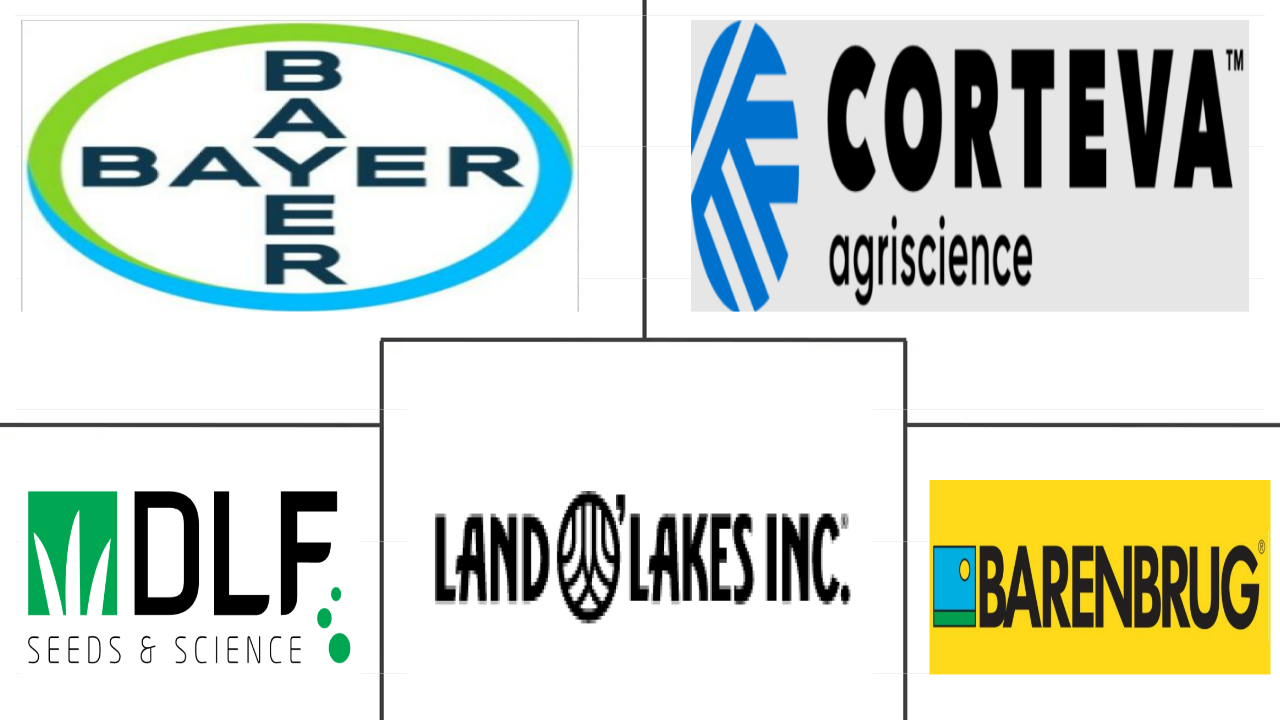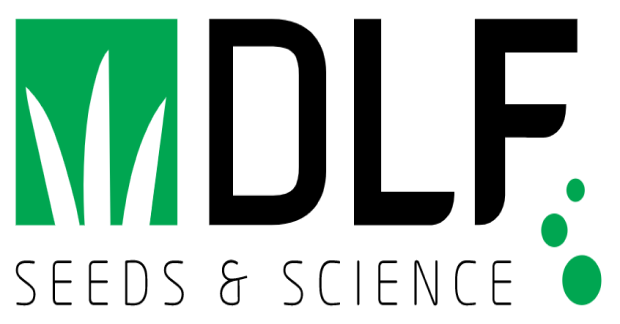Market Size of forage seed Industry
| Icons | Lable | Value |
|---|---|---|
|
|
Study Period | 2017 - 2030 |
|
|
Market Size (2024) | USD 4.75 Billion |
|
|
Market Size (2030) | USD 5.99 Billion |
|
|
Largest Share by Breeding Technology | Hybrids |
|
|
CAGR (2024 - 2030) | 3.96 % |
|
|
Largest Share by Region | North America |
|
|
Market Concentration | Low |
Major Players |
||

|
||
|
*Disclaimer: Major Players sorted in no particular order |
Forage Seed Market Analysis
The Forage Seed Market size is estimated at 4.75 billion USD in 2024, and is expected to reach 5.99 billion USD by 2030, growing at a CAGR of 3.96% during the forecast period (2024-2030).
4.75 Billion
Market Size in 2024 (USD)
5.99 Billion
Market Size in 2030 (USD)
4.92 %
CAGR (2017-2023)
3.96 %
CAGR (2024-2030)
Largest Market by Crop
22.87 %
value share, Alfalfa, 2023
Alfalfa is in high demand in the region by dairy farmers for animal feed. It can be harvested 10-12 times per crop season and has high nutritional protein content.
Largest Market by Country
19.81 %
value share, Canada, 2023
The demand for forage crops in the country is on the rise, primarily due to the adoption of high-yielding varieties and growing government initiatives to encourage forage growers.
Fastest-growing Market by Crop
4.41 %
Projected CAGR, Forage Sorghum, 2024-2030
The increasing demand for forage sorghum is due to the development of dual-purpose varieties, preference for sorghum silage, and availability of highly nutritious varieties.
Fastest-growing Market by Country
7.23 %
Projected CAGR, Iran, 2024-2030
Iran has a high demand for forage crops due to the high demand for better-quality meat, increasing cattle population, and awareness about quality feed among farmers.
Leading Market Player
9.94 %
market share, DLF, 2022

DLF Seeds is the most active company in the forage seed market, which has increased its revenue through product innovations, partnerships, and mergers and acquisitions.
Hybrids dominate the forage seed market with the higher growth potential concerning the open-pollinated varieties.
- The livestock population is increasing across the regions. The increase in livestock population needs an expansion of the area under forages and demands the use of varieties with high yield potential and a high feed value. This is one of the major factors leading to the growth of the hybrid and open-pollinated seed market.
- Major companies are investing in improving seed quality due to increased demand. For instance, in 2021, DLF Seeds, the world’s leading grass seed breeder, invested USD 4.6 million in new state-of-the-art mixing and distribution facilities. The investment will transform their current production facilities of OPVs and the hybrid seed of forage and bring much-needed additional capacity and efficiency to cope with the future market demands in the amenity, consumer, and environmental stewardship in the forage seed market.
- The hybrid seed segment dominates the market due to the increased adoption and awareness about its benefits. The hybrid seed market segment is estimated to increase by a CAGR of 3.9% during the forecast period due to the rise in the seed replacement rate and the availability of improved varieties in the market.
- The farmer's preference for transgenic varieties is slowly rising in various forage-growing regions due to increased crop losses due to weeds and diseases. Therefore, the transgenic segment is growing with a CAGR of 5% during the forecast period.
- The Asia-Pacific forage seed market using OPVs seeds is projected to be the fastest growing, at a CAGR of 4.3% during the forecast period because open-pollinated varieties require fewer inputs, such as fertilizer and pesticides, and are less expensive and more affordable for small holding and low-income farmers.
North America and Europe are leading forage seed markets in the world due to the large demand for forage seeds in these regions
- Globally, North America holds a major share, accounting for 42.3% of the global forage seeds market in terms of value in 2022 due to the increase in the demand for forage as feed, an increase in meat consumption, and weather conditions. In North America, the United States has the largest forage seed market, accounting for 37.0% of North America's forage seed market in 2022. This is due to the high demand for forage as feed and the increase in the cattle population in the country.
- Europe was the primary producer of forages. It contributed 26.7% to the global forage seed market in 2022. The increase in livestock production and consumption is driving the forage market in the region. Germany is the largest producer of forage crops in Europe, with a market share of 29.4% in the region's forage seed market in 2022.
- Asia-Pacific accounted for about 15.1% of the global forage seed market in 2022. India has the largest forage seed market in the region, and it accounted for 18% of the Asia-Pacific forage seed market in terms of value in 2022. The growing demand for forage crops due to the growing livestock sector in the region is anticipated to drive the region's forage seed market, registering a CAGR of 2.7% during the forecast period.
- In 2022, South America had a market share of 11.3% of the global forage seed market. Alfalfa is the major forage crop grown in South America. The availability of GM hybrids of alfalfa that are herbicide-resistant and tolerant to water stress and high lignin content for better digestibility is driving the transgenic alfalfa seed market in South America, and it is expected to register a CAGR of 4.2%.
- The increasing demand due to the increased livestock population is anticipated to drive the market during the forecast period.
Forage Seed Industry Segmentation
Hybrids, Open Pollinated Varieties & Hybrid Derivatives are covered as segments by Breeding Technology. Alfalfa, Forage Corn, Forage Sorghum are covered as segments by Crop. Africa, Asia-Pacific, Europe, Middle East, North America, South America are covered as segments by Region.
- The livestock population is increasing across the regions. The increase in livestock population needs an expansion of the area under forages and demands the use of varieties with high yield potential and a high feed value. This is one of the major factors leading to the growth of the hybrid and open-pollinated seed market.
- Major companies are investing in improving seed quality due to increased demand. For instance, in 2021, DLF Seeds, the world’s leading grass seed breeder, invested USD 4.6 million in new state-of-the-art mixing and distribution facilities. The investment will transform their current production facilities of OPVs and the hybrid seed of forage and bring much-needed additional capacity and efficiency to cope with the future market demands in the amenity, consumer, and environmental stewardship in the forage seed market.
- The hybrid seed segment dominates the market due to the increased adoption and awareness about its benefits. The hybrid seed market segment is estimated to increase by a CAGR of 3.9% during the forecast period due to the rise in the seed replacement rate and the availability of improved varieties in the market.
- The farmer's preference for transgenic varieties is slowly rising in various forage-growing regions due to increased crop losses due to weeds and diseases. Therefore, the transgenic segment is growing with a CAGR of 5% during the forecast period.
- The Asia-Pacific forage seed market using OPVs seeds is projected to be the fastest growing, at a CAGR of 4.3% during the forecast period because open-pollinated varieties require fewer inputs, such as fertilizer and pesticides, and are less expensive and more affordable for small holding and low-income farmers.
| Breeding Technology | |||||||
| |||||||
| Open Pollinated Varieties & Hybrid Derivatives |
| Crop | |
| Alfalfa | |
| Forage Corn | |
| Forage Sorghum | |
| Other Forage Crops |
| Region | ||||||||||||||||||
| ||||||||||||||||||
| ||||||||||||||||||
| ||||||||||||||||||
| ||||||||||||||||||
| ||||||||||||||||||
|
Forage Seed Market Size Summary
The forage seed market is experiencing significant growth, driven by the increasing livestock population and the subsequent demand for high-yield and high-feed-value forage varieties. This demand is prompting major companies to invest in improving seed quality and expanding production capabilities. The hybrid seed segment is particularly dominant due to its benefits, such as higher seed replacement rates and improved varieties. The market is also witnessing a gradual rise in the preference for transgenic varieties, which are gaining traction in regions facing crop losses from weeds and diseases. The Asia-Pacific region, especially with open-pollinated varieties, is projected to be the fastest-growing market segment, appealing to smallholders due to lower input costs.
Regionally, North America holds a substantial share of the global forage seed market, with the United States leading due to its high demand for forage as animal feed. Europe remains a key producer, with Germany at the forefront, driven by increased livestock production. The Asia-Pacific region, particularly India, is expanding its forage cultivation area, fueled by a growing livestock sector. South America is also seeing growth, with transgenic alfalfa seeds gaining popularity. The market is characterized by a diverse range of forage crops, with alfalfa and forage corn being prominent due to their digestibility and high protein content. Companies are focusing on developing varieties with traits like early maturity and disease resistance to meet the evolving demands of the market.
Forage Seed Market Size - Table of Contents
-
1. MARKET SEGMENTATION (includes market size in Value in USD, Forecasts up to 2030 and analysis of growth prospects)
-
1.1 Breeding Technology
-
1.1.1 Hybrids
-
1.1.1.1 Non-Transgenic Hybrids
-
1.1.1.2 Transgenic Hybrids
-
1.1.1.2.1 Herbicide Tolerant Hybrids
-
1.1.1.2.2 Other Traits
-
-
-
1.1.2 Open Pollinated Varieties & Hybrid Derivatives
-
-
1.2 Crop
-
1.2.1 Alfalfa
-
1.2.2 Forage Corn
-
1.2.3 Forage Sorghum
-
1.2.4 Other Forage Crops
-
-
1.3 Region
-
1.3.1 Africa
-
1.3.1.1 By Breeding Technology
-
1.3.1.2 By Crop
-
1.3.1.3 By Country
-
1.3.1.3.1 Egypt
-
1.3.1.3.2 Ethiopia
-
1.3.1.3.3 Ghana
-
1.3.1.3.4 Kenya
-
1.3.1.3.5 Nigeria
-
1.3.1.3.6 South Africa
-
1.3.1.3.7 Tanzania
-
1.3.1.3.8 Rest of Africa
-
-
-
1.3.2 Asia-Pacific
-
1.3.2.1 By Breeding Technology
-
1.3.2.2 By Crop
-
1.3.2.3 By Country
-
1.3.2.3.1 Australia
-
1.3.2.3.2 Bangladesh
-
1.3.2.3.3 China
-
1.3.2.3.4 India
-
1.3.2.3.5 Indonesia
-
1.3.2.3.6 Japan
-
1.3.2.3.7 Myanmar
-
1.3.2.3.8 Pakistan
-
1.3.2.3.9 Philippines
-
1.3.2.3.10 Thailand
-
1.3.2.3.11 Vietnam
-
1.3.2.3.12 Rest of Asia-Pacific
-
-
-
1.3.3 Europe
-
1.3.3.1 By Breeding Technology
-
1.3.3.2 By Crop
-
1.3.3.3 By Country
-
1.3.3.3.1 France
-
1.3.3.3.2 Germany
-
1.3.3.3.3 Italy
-
1.3.3.3.4 Netherlands
-
1.3.3.3.5 Poland
-
1.3.3.3.6 Romania
-
1.3.3.3.7 Russia
-
1.3.3.3.8 Spain
-
1.3.3.3.9 Turkey
-
1.3.3.3.10 Ukraine
-
1.3.3.3.11 United Kingdom
-
1.3.3.3.12 Rest of Europe
-
-
-
1.3.4 Middle East
-
1.3.4.1 By Breeding Technology
-
1.3.4.2 By Crop
-
1.3.4.3 By Country
-
1.3.4.3.1 Iran
-
1.3.4.3.2 Saudi Arabia
-
1.3.4.3.3 Rest of Middle East
-
-
-
1.3.5 North America
-
1.3.5.1 By Breeding Technology
-
1.3.5.2 By Crop
-
1.3.5.3 By Country
-
1.3.5.3.1 Canada
-
1.3.5.3.2 Mexico
-
1.3.5.3.3 United States
-
1.3.5.3.4 Rest of North America
-
-
-
1.3.6 South America
-
1.3.6.1 By Breeding Technology
-
1.3.6.2 By Crop
-
1.3.6.3 By Country
-
1.3.6.3.1 Argentina
-
1.3.6.3.2 Brazil
-
1.3.6.3.3 Rest of South America
-
-
-
-
Forage Seed Market Size FAQs
How big is the Global Forage Seed Market?
The Global Forage Seed Market size is expected to reach USD 4.75 billion in 2024 and grow at a CAGR of 3.96% to reach USD 5.99 billion by 2030.
What is the current Global Forage Seed Market size?
In 2024, the Global Forage Seed Market size is expected to reach USD 4.75 billion.

